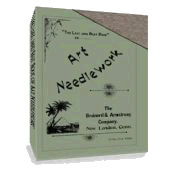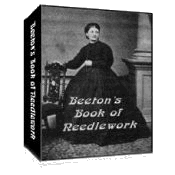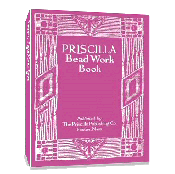[]Subscribe To This Site
Ribbon Embroidery
Ribbon embroidery, sometimes called “China ribbon embroidery,” “ribbon work” or “rococo,” is one of the oldest forms of raised embroidery, and was much used in the 1800’s; it has had, from time to time, a revival of popularity in this.
Below is a sample of a Ribbonwork Reticule (bag) dated c. 1840. It is of mid brown silk satin with drawstring, both sides worked with carnations, fushias, daisies and other flowers all in shaded ribbonwork in crimson, pink, coral, green, yellow and ivory, the stems embroidered in fine green twisted silks, the stamens in coloured silks, lined with pink silk, 8 1/2 in; 22 cm.



The earlier ribbon embroidery designs were worked out with a narrow China ribbon about one-half inch in width. This ribbon was dyed with beautiful shades in art tones, as old blue, dead rose, sage green, etc. Some of the ribbons were shaded from light on one edge to dark on the other, and thus formed effective shading.

Click on picture to see more detail.
The designs for working the ribbon were of the smaller flowers or of the larger ones drawn in miniature and arranged as Kensington designs are now made. Also Louis XVI designs – arrangement of flowers in various devices – were designed on satin bed coverings and door hangings in detached groups or in continuous garlands around the borders, with clusters powdered over the center.
To work: For the leaves, thread a long-eyed needle with a green ribbon, bring it up from the back of the material, at the point of the leaf, and put it through to the back again at the base of the leaf; this, in case of long-pointed leaves, and also for the petals of star-shaped flowers. Where the leaf is broad, the ribbon is worked in satin stitch, taking the stitch from one edge of the center of a leaf at an angle; the reverse side being worked in the same manner, forms a vein in the center.
For double flowers in miniature, as asters, roses, etc., shaded ribbon was used. This was gathered full on the darker edge, which was sewed on the design, beginning in the center and sewing around toward the outer edge, until the design was filled in. for very small single flowers the ribbon was threaded in the needle, as for the leaves, and a single stitch taken from top to bottom of petal. The centers of flowers were put in with filo floss in French Knot.
The illustration below was taken from a piece of work c1830, and intended for a sachet or handbag. The foundation is of black satin, and the colors used are as follows: Commencing from the top left-hand corner, the spray there is formed of pink and white ribbon intermixed, the large flower, of amber colored shaded ribbon, with buds of a deeper tone, and the small bunch of flowers beneath it, blue with yellow centers. On the right hand, the small flowers at the top are yellow, the rose of gathered ribbon of a plain crimson shade, and the bunch of small flowers above it, white with pink centers. The rose in the center is formed by the ribbon being closely gathered as before described, the color a variegated deep red; the little two petal flowers over it are rose color, and its left side are yellow and white; the four-petal flowers underneath rose pink and white centers; leaves throughout of shaded yellow greens. Form all stems, rose thorns, and other fine parts of the pattern of green purse silk, and work in Stem or Crewel stitch. The above are the shades used upon this old piece of work, and, as none of them are produced from aniline dyes, they amalgamate extremely well.

Click on picture to see more detail.
This form of ribbon work was indulged in by the wealthy only, as the ribbon was a foreign manufacture, and not imported into this country, except by the decorative art societies which made a specialty of keeping ribbons and designs for this work. A cushion with Lois XVI design working in this manner here described is in the possession of the Chicago Society of Decorative Art. On the other hand, if one had friends in Paris, the ribbon could be there purchased for a few cents per yard, and good designs can be traced from prints of decorations of the Louis XVI period. The ribbon embroidery work above described is the highest form of raised work indulged in even at the present day. As the designs for it are of a light and graceful character and the tints of the ribbon exceedingly delicate, it follows that the background on which it is to be applied should also be of a light or medium tone, and satin or silk offers by far the best surface.
Return to top of Ribbon Embroidery page.
Return to Types of Embroidery page.
Return to Special Designs page.
Return to Home page.



 433 pages!
433 pages!

